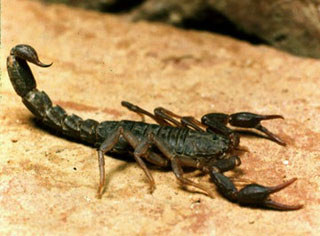Giant scorpions 460 million years ago were larger than humans
 Washington, Nov 21: Biologists have discovered a giant fossilized claw of an ancient sea scorpion in Germany, which when alive, would have been much taller than the average man. This suggests that animals like spiders, insects, crabs and similar creatures were much larger in the past than previously thought.
Washington, Nov 21: Biologists have discovered a giant fossilized claw of an ancient sea scorpion in Germany, which when alive, would have been much taller than the average man. This suggests that animals like spiders, insects, crabs and similar creatures were much larger in the past than previously thought.
Discovered by Markus Poschmann from the University of Bristol, the fossil was found from rocks that were 390 million years old in a quarry near Prüm in Germany.
"I was loosening pieces of rock with a hammer and chisel when I suddenly realized that there was a dark patch of organic matter on a freshly removed slab. After some cleaning, I could identify this as a small part of a large claw,” said Poschmann.
The pieces had to be cleaned separately, dried, and then glued back together. It was then put into a white plaster jacket to stabilize it.
The claw is from a sea scorpion (eurypterids) that lived between 460 and 255 million years ago. It is 46 centimetres long, indicating that the sea scorpion to which it belonged was around 2.5 metres (8 feet) long, which is almost half a metre longer than previous estimates for these arthropods and the largest one ever to have evolved.
'This is an amazing discovery. We have known for some time that the fossil record yields monster millipedes, super-sized scorpions, colossal cockroaches, and jumbo dragonflies, but we never realised, until now, just how big some of these ancient creepy-crawlies were,” said Dr Simon Braddy from the Department of Earth Sciences at the University of Bristol.
Eurypterids are believed to be the extinct aquatic ancestors of scorpions and possibly all arachnids.
Some geologists believe that giant arthropods evolved due to higher levels of oxygen in the atmosphere in the past, while others believe that they evolved in an 'arms race' alongside their likely prey - the early armoured fish.
“There is no simple single explanation 'for the massive size of these arthropods,” said Braddy. 'It is more likely that some ancient arthropods were big because there was little competition from the vertebrates, as we see today,” he added. (ANI)